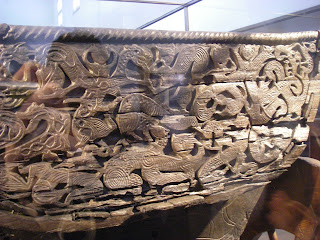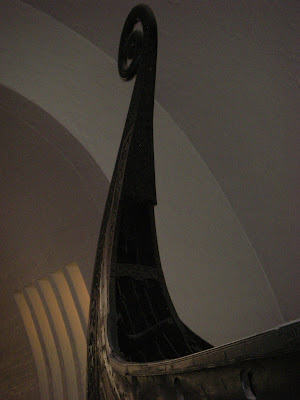1000 Places To See Before You Die 15 - The Viking Ship Museum, Oslo (Vikingskipshuset på Bugdøy)
This small museum is part of the museum of Cultural History of the University of Oslo and it houses 3 famous Viking Age ships, as well as some other Viking Age finds. The most famous ship on display is the complete Oseberg ship, which was excavated from the largest know ship burial in the world.
The museum is built specifically to house the ships and other Viking Age finds from the late 19th and early 20th centuries. Arnstein Arneberg won the architectural contest and his building was finished in 1957, the last parts of it delayed due to World War II. The ships were moved as soon as their respective halls were finished and the Oseberg ship moved in in 1926, while the ships from Gokstad and Tune moved in in 1931.
As mentioned above the Oseberg ship is probably the most famous item in the museum. It was deposited in a burial mound in 834 AD, but the ship itself is thought to be older than 800 AD. It was excavated in 1904-1905 by the Norwegian archaeologist Haakon Shetelig and the Swedish archaeologist Gabriel Gustafson. It is usually considered one of the finest finds we have from the Viking Age.
The ship is a clinker built vessel, almost entirely of oak. It is ca. 22 m long and just over 5 m wide. Up to 30 people could row the ship and under sail it could achieve up to 10 knots. The bow and stern of the ship is decorated with elaborate carvings. The ship would have been able to sail, but it would have been relatively frail and it is thought it was only used for coastal voyages, avoiding the rougher conditions on the open sea. A modern replica of this ship has sunken twice in moderate weather because the ship lacks freeboard and essentially took in too much water. There has been some debate about whether or not to move the ships to a more suitable location, as the small museum can easily become crowded and there are concerns about fire safety. During these discussions thorough examinations were made and the entire ship was laser scanned. In 2004 it was decided to build a new replica of the ship, using the very detailed data obtained with the laser scanning. During this work it was discovered that the initial restoration of the ship was flawed in that a breach had been made in a beam, causing the entire ship to be shortened. Using these new data the replica Saga Oseberg was built and this performed very well, also on the open sea. This proved that the Oseberg ship had been a fully functioning ship and was not built specifically for the burial chamber.
In the Oseberg ship two women were buried; one older about 60-70 years old and one slightly younger at about 50-55 years old. It is not possible to determine which of these two was the most important, or if one was sacrificed to accompany the other to the afterworld. The two women had a number of grave goods, including 4 elaborately decorated wooden sleighs, bed-posts, wooden chests, a cart and a number of smaller tools and textiles.The ship burial and the accompanying grave goods show that this was a burial for someone very significant. The mound had been looted in ancient times and precious metals had been removed.
Another famous ship on display at the museum is the Gokstad ship. This was also excavated from a burial mound, although a bit earlier. In 1880 sons of the landowner on which the mound was situated decided to start digging, having heard legends concerning the origin of the mound. They uncovered the bow of a boat and Nicolay Nicolaysen, the president of the Society for the Preservation of Ancient Norwegian Monuments, heard of this find and managed to stop the young men and conduct a more professional excavation. The ship is clinker built and mainly of oak, as the Oseberg ship. It is almost 24 m long and just over 5 m wide, and is the largest Viking ship in Oslo. Up to 32 men could row the ship, and under sail it could achieve a speed of 12 knots. It is dated to about 890 AD, and falls within the reign of king Harald Fairhair. Many replicas have been made of the ship and it has been proved to be very seaworthy.
The skeleton of a 40-50 year old male was found inside a timber-built burial chamber of the ship. The grave goods consisted of 3 small boats, a tent, a sledge and riding equipment. The burial had been disturbed in ancient times and precious metals and weapons were probably removed at this time.
The third large ship on display at the museum is the Tune ship. It was built around 900 AD and is also clinker built of oak planks. Similarly it was also part of a burial mound and was excavated by Oluf Rygh in 1867. Only part of the ship survives but it is thought to have been up to 22 m long. It is just under 4,5 m long and could have 11 or 12 pairs of oars.
Visiting the museum is a must if you are in Oslo. The ships are beautiful in themselves, even if you are not particularly interested in history or archaeology. You can delve into the details of craftsmanship on the ships themselves and on the grave goods accompanying the ships, and you can spend anywhere from 15 minutes to several hours in the place, depending on your level of interest.
All facts are from “1000 Places to See Before You Die” by Patricia Schultz and Wikipedia


















Comments
Post a Comment